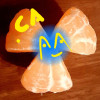Could the fabric of space be the origin of baryon matter?
I’ve been doing a bit of searching for theories on the origin of baryon matter (including antimatter of course) and some seem to hint at quantum particles spawning from the fabric of space (but doesn’t seem to theorize on how this happened) but not many focus on hypothesizing how all forms of baryon matter ether: was the default starting point (that is empty space wasn’t the default origin, energy was) or that the fabric of space is the origin of baryon matter (something like: space has the blue print and energy supplies the material).
Thanks for any insight/links that focus on this question


Add comment